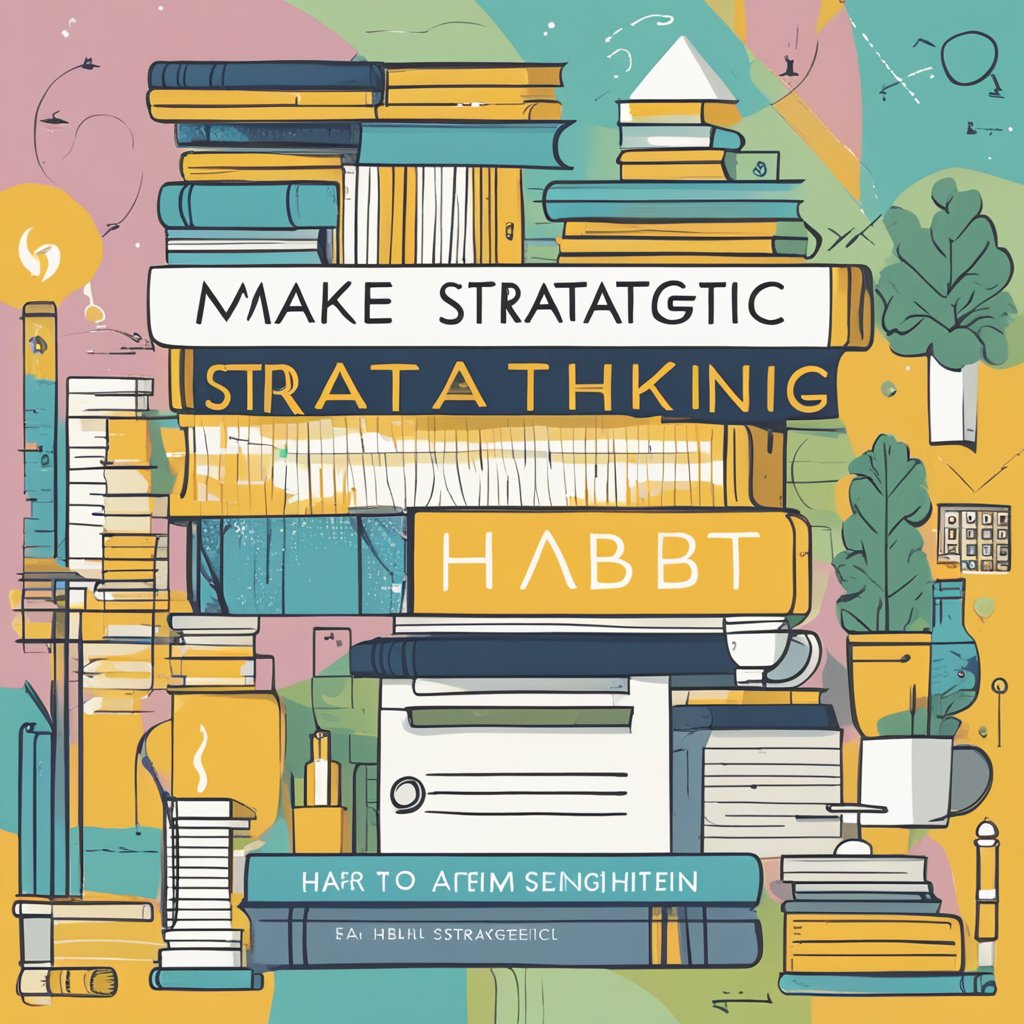Strategic thinking is an essential skill that enables professionals to make informed decisions, navigate the complexities of their industries, and adapt to an ever-changing business landscape. Yet, it is not a natural ability for everyone; instead, it requires practice and dedication. By making strategic thinking a habit, individuals can optimize their decision-making capabilities, solve problems more effectively, and create a forward-thinking vision that benefits their organizations.


Incorporating strategic thinking into one’s daily routine involves understanding its core principles, studying successful leaders, leveraging tools and strategies, and applying those concepts within their organization. Over time, individuals will become more proficient in navigating assumptions and biases, evaluating their effectiveness, and recognizing the importance of innovation and initiative in maintaining a competitive edge.
Key Takeaways
- Making strategic thinking a habit leads to informed decision-making and effective problem-solving in complex business environments.
- Developing this habit involves learning from leaders, using tools and strategies, and applying concepts within organizations.
- Overcoming assumptions and biases, embracing innovation, and evaluating effectiveness are essential components of strategic thinking proficiency.
Understanding Strategic Thinking


Strategic thinking is a crucial skill for leaders and management in various industries. It refers to the ability to see the bigger picture, anticipate future challenges and opportunities, and make informed decisions that align with the organization’s goals. Strategic thinkers possess high-level insight, allowing them to navigate complex situations while keeping long-term objectives in mind.
To develop strategic thinking, individuals must first understand its key components. One essential aspect is analytical skills, which enable thinkers to process diverse inputs like financial statements, market conditions, and emerging business trends. By analyzing these factors, strategic thinkers can devise strategies that help their organization achieve its objectives.
Another critical aspect of strategic thinking is considering different perspectives. Leaders must encourage team members to speak their minds and provide input from varying viewpoints. As highlighted by Harvard Business Publishing, this inclusive environment fosters better decision-making, as it allows organizations to spot opportunities and threats in advance.
Developing strategic thinking skills can be facilitated through deliberate practice and habit formation. This involves setting aside dedicated time for strategic reflection and analysis. As described by Brown University CareerLAB, incorporating strategic thinking into one’s daily routine ensures efficient use of time, energy, and effort at work.
In summary, strategic thinking is a valuable skill that enables leaders and management to make better decisions, anticipate challenges, and identify opportunities. By practicing analytical skills and encouraging diverse perspectives, individuals can enhance their strategic thinking capabilities, ultimately benefiting their organizations and their career paths.
Why Make Strategic Thinking a Habit


Strategic thinking is essential because it allows individuals to make better decisions, solve problems effectively, and prepare for future challenges. By cultivating strategic thinking as a daily habit, individuals can greatly improve their skills in planning, organizing, and problem-solving.
The benefits of strategic thinking span across various aspects of a person’s life. By incorporating it into one’s routine, individuals will notice improvements in their personal and professional lives. It can help establish long-term goals and effectively allocate resources to achieve them. Moreover, strategic thinking can enhance innovation and adaptability, both crucial for success in today’s fast-paced world.
Time management plays a significant role in developing strategic thinking. To make it a habit, it is essential to set aside time regularly for reflection, planning, and analysis. This practice helps individuals become proactive, anticipate potential challenges, and make thoughtful choices that yield future dividends.
Incorporating strategic thinking into various areas of one’s life allows individuals to plan for the long game. It not only involves considering immediate concerns but also considering how decisions made today can influence future outcomes. By employing a strategic mindset, individuals can identify patterns, assess opportunities, and optimize resources to achieve long-term success.
In conclusion, making strategic thinking a habit has far-reaching advantages for a person’s personal and professional life. Mastering this skill can make a significant impact on decision-making, problem-solving, and planning for the future. By committing to incorporating strategic thinking into their daily routine, individuals can unlock its potential and experience its dividends in every aspect of their lives.
Learning from Leaders in Strategic Thinking


Dorie Clark, a renowned leader in strategic thinking, has contributed significantly to this field through her work as a consultant, author, and speaker. Her insights and ideas offer valuable guidance for those looking to enhance their strategic thinking skills and transform them into a habit.
One of Clark’s notable works, the book Reinventing You, provides readers with a roadmap for personal and professional transformation. By tapping into her expertise, individuals can identify their unique strengths, develop a compelling personal brand, and create a customized plan to achieve their goals.
Another significant contribution from Dorie Clark is her book, Standout, which aims to help professionals identify their breakthrough ideas and build a following around them. This work offers a practical guide on how to develop innovative ideas, present them effectively, and gain support from others.
In addition to her published works, Clark also shares her thoughts on leadership and strategic thinking through various platforms such as LinkedIn Learning and Harvard Business Review. These resources enable individuals and businesses to access her expertise and apply her suggestions for cultivating strategic thinking as a habit.
Aspiring strategic thinkers can find ample inspiration and guidance in Dorie Clark’s work. By immersing themselves in her books and resources, individuals can explore practical tools and techniques for honing their strategic thinking skills and making it an ingrained habit in their professional lives. By learning from a leader in the field, they can develop the confidence, knowledge, and clarity needed to thrive in today’s fast-paced world.
Tools and Strategies for Developing the Habit
Strategic thinking is a crucial skill for success in leadership roles, as it enables individuals to properly plan for the future, and efficiently allocate resources towards achieving the organization’s objectives. Developing strategic thinking skills can be achieved through a combination of tactics and approaches that foster a thoughtful and proactive mindset.
Firstly, it’s important to consistently analyze and evaluate your organization’s performance. Analytical skills are a key component of strategic thinking, as they enable leaders to assess various aspects of their business, such as financial statements, market conditions, and internal resource allocation. Regularly reviewing key performance indicators (KPIs) and identifying trends can provide valuable insights to guide strategic decision-making.
Moreover, utilizing tools and frameworks can help leaders systemize their strategic thinking process. For instance, techniques like SWOT analysis, PESTLE analysis, and scenario planning can be used for identifying opportunities, risks, and anticipating changes in the business environment. Integrating these tools into everyday practice will cultivate a strategic thinking mindset.
Learning platforms such as LinkedIn Learning offer numerous courses and resources to help professionals develop their strategic thinking skills. By taking advantage of these resources, leaders can better understand the concepts, techniques, and habits that contribute to effective strategic thinking, and integrate these practices into their daily workflow.
In addition, seeking guidance and mentorship from experienced leaders can provide valuable insights into effective strategic thinking habits. Engaging in conversations, asking questions, and seeking feedback from others with expertise in strategic thinking can provide a wealth of knowledge and support on the journey towards developing this critical skill.
Finally, it’s essential to approach strategic thinking with a growth mindset, being open to learning, evolving, and continuously improving one’s skills. Aspiring leaders must be confident and knowledgeable in their ability to make informed decisions and communicate their strategic vision. Embracing continuous learning and development, both in theory and practice, will help foster a strategic thinking habit and enhance overall leadership effectiveness.
Applying Strategic Thinking in an Organization
Strategic thinking can be a game-changer for organizations when applied effectively. This cognitive skill can enhance the decision-making process for managers and their teams, creating a more efficient and effective company.
One essential aspect of implementing strategic thinking is to encourage employee involvement at all levels. This powerful mindset can lead to innovative ideas and solutions that may not have surfaced from traditional top-down management decision-making. By engaging everyone in the organization, companies can harness the full potential of strategic thinking, allowing them to stay ahead in competitive markets.
It’s crucial for management to cultivate an environment that fosters strategic thinking. This can be achieved by organizing workshops, training sessions, and team-building activities aimed at fostering better understanding and collaboration. Implementing mentorship programs and providing opportunities for employees to develop and apply their analytical skills can also contribute to creating a more strategic-minded team.
Incorporating strategic thinking into the organization’s decision-making process is vital. Top management should be transparent about the company’s strategic objectives and align projects with clear goals. This clear alignment will enable employees to better understand the company’s overall direction and focus their efforts on initiatives that support those objectives.
Finally, it’s essential to remember that strategic thinking goes beyond short-term gains. A forward-thinking organization should continually scan the external environment for emerging trends, market shifts, and new opportunities to stay ahead and maintain a competitive advantage.
By embracing strategic thinking in an organization, companies can foster an environment that nurtures innovation, agility, and preparedness. This will ultimately contribute to the achievement of long-term objectives and sustained growth.
The Role of Innovation and Initiative
Innovation is a crucial driver of growth for any organization in today’s rapidly evolving landscape. It serves as the catalyst to develop products, services, or processes which enhance the organization’s capacity to address emerging challenges. To make strategic thinking a habit, organizations must focus on nurturing a culture of innovation that encourages employees to take initiatives and stay ahead of the curve.
A key aspect of incorporating innovation and initiative into strategic thinking is enabling employees to identify potential opportunities. By fostering a mindset of proactive ideation and exploration, the organization positions itself to capitalize on new opportunities and stay adaptable in changing environments. Moreover, cultivating this mindset supports strategic planning efforts, as it encourages the organization to embrace future possibilities and remain alert to shifts within their industries.
To embed innovation and initiative into the organization’s DNA, it is essential to establish systems that incentivize creative problem-solving and empower employees to drive change. These can include rewarding employees for innovative ideas, providing resources for employee-led projects, or dedicating time to brainstorming sessions where employees can freely exchange ideas without fear of judgment.
By applying bold and innovative initiatives in strategic planning, organizations can effectively leverage new technologies, business models, and market conditions to stay ahead of the competition. This approach enables them to develop a forward-thinking, agile mentality that can capitalize on emerging opportunities and position the organization for long-term success.
In summary, the integration of innovation and initiative into strategic thinking plays a pivotal role in helping organizations thrive in an ever-changing landscape. By nurturing a culture of innovation and encouraging employees to take the initiative, organizations can seize emerging opportunities and effectively execute their strategic objectives.
Overcoming Assumptions and Biases
In order to make strategic thinking a habit, one must learn to overcome assumptions and biases that can hinder clear decision-making processes. Assumptions can prevent individuals from considering alternative options, while biases can cloud judgment and impair the ability to make informed choices.
One essential approach to overcoming assumptions is to seek feedback. Actively engaging with others who have diverse perspectives, experiences, and backgrounds can help validate or invalidate assumptions. This broadens one’s understanding of a situation and can lead to more insightful decision-making. By re-examining preconceived notions and stepping out of one’s comfort zone, it opens up a wider range of opportunities for growth and success.
Practicing reflective thinking is another strategy to challenge assumptions and biases. This self-awareness practice entails monitoring and updating decision-making processes, assessing the validity of beliefs, and considering alternative viewpoints. Reflective thinking helps maintain a neutral mindset and promotes critical analysis of situations.
One tactic to minimize the impact of biases is anchoring. Anchoring bias occurs when too much reliance is placed on the first piece of information encountered. To counteract this, individuals must expose themselves to diverse sources of information and allow for adjustments in their understanding of situations. Another common bias is overconfidence bias, where people tend to overestimate their abilities or knowledge. To mitigate this, fostering a growth mindset and a humble attitude can help ensure more balanced decisions.
In becoming proficient at strategic thinking, it’s crucial to acknowledge the existence of assumptions and biases, and to actively work towards overcoming them. By incorporating these strategies, strategic thinkers can establish a habit of consistently making well-informed and confident decisions.
Evaluating Your Effectiveness
In order to make strategic thinking a habit, it’s essential to evaluate your effectiveness on an ongoing basis. This involves examining your ability to identify opportunities, allocate resources, and create a clear and compelling direction for yourself or your organization.
One way to assess your effectiveness is by regularly reviewing your goals and the progress made towards achieving them. This can be done through the use of Key Performance Indicators (KPIs) or benchmarks that measure your success. For instance, if your objective is to increase market share, you could track growth in sales, customer retention, or customer acquisition.
Another essential aspect of evaluating your effectiveness in strategic thinking is ensuring that you’re staying current on market conditions and emerging trends in your industry. By actively monitoring relevant news, research, and competitor activities, you can maintain a comprehensive understanding of the ever-changing landscape, which allows you to make informed decisions and uncover new opportunities.
Additionally, solicit feedback from colleagues, mentors, or supervisors to gain insight into areas where you may need improvement. This will help you identify blind spots in your strategy and make adjustments as needed. It’s important to maintain a growth mindset, embracing the idea that there’s always something new to learn or a skill to enhance in order to become more effective.
In summary, evaluating your effectiveness in strategic thinking requires consistent goal-setting and progress tracking, staying informed on market trends, and actively seeking feedback from others. By incorporating these practices into your routine, you’ll be better equipped to identify opportunities and make informed decisions that contribute to your organization’s success.





